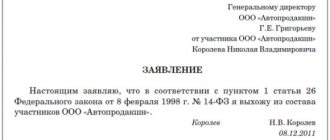Transfer act during reorganization in the form of transformation
JSC "___________" represented by _________________, acting___ on the basis of _______________, on the one hand, and ___________________ represented by ________________, acting___ on the basis of ________________, on the other hand, drew up this act stating that in accordance with Art. 58, 59 of the Civil Code of the Russian Federation and the decision of the general meeting of shareholders of JSC "______" dated "__"______ ___, minutes No. _______ (by the decision of the sole shareholder of JSC "________" dated "___"________ ___, N _____) on reorganization in the form of transformation , all rights and obligations of JSC “________” are transferred to the newly created _____________, namely:
— Accounting documents (balance sheets, profit and loss statements, appendices to the financial statements provided for by the regulations of the Russian Federation, audit reports confirming the accuracy of the financial statements, explanatory notes).
Transfer act during reorganization in the form of transformation
Closed Joint Stock Company "Romashka", OGRN ***, INN ***, KPP ***, location: ***, represented by ***, acting on the basis of the Charter and the Decision on reorganization in the form of transformation, hereinafter referred to as " Participant in the transformation", on the one hand, and the Limited Liability Company "Dandelion", location: ***, represented by ***, acting on the basis of the Charter and the decision on reorganization in the form of transformation, hereinafter referred to as the "Assignee", on the other the parties have drawn up this Transfer Deed, which determines the scope of the rights and obligations transferred by the Participant in the transformation to the Assignee.
The participant in the transformation handed over to the Assignee the following documents drawn up in accordance with Order of the Ministry of Finance of the Russian Federation dated May 20, 2003 N 44n “On approval of the Guidelines for the preparation of financial statements during the reorganization of organizations”: 1) Balance sheet as of 03/05/2011 2) Report on profits and losses as of 03/05/2011 3) Act (inventory) of inventory of property and liabilities as of 03/05/2011 4) Inventory of primary accounting documents for material assets and other property transferred as a result of reorganization as of 03/05/2011 5 ) Breakdown of accounts payable and receivable as of 03/05/2011.
Transformation of LLC into CJSC (OJSC) – registration in the palm of your hand
Transforming an LLC into a joint stock company is one of the simplest forms of enterprise reorganization, from the point of view of legal and accounting standards. However, the stages of transformation that an enterprise must go through are not much different from the procedure for reorganization in more complex forms. Violation of the procedure for registering the transformation may lead to its recognition as invalid.
- financial statements of the reorganized Company;
- act (inventory) of inventory of property and liabilities of the reorganized Company;
- primary accounting documents on material assets, lists (inventory) of other property subject to acceptance and transfer during the reorganization of organizations
- decoding (inventory) of accounts payable and receivable with information about written notification within the established time frame to the Company's creditors and debtors, information about settlements with the relevant budgets, state extra-budgetary funds, etc.
It is recommended that the transfer act be drawn up at the end of the reporting period (year) or the date of preparation of interim financial statements (quarter, month), which is the basis for the characterization and assessment of the transferred property and liabilities by the reorganized organization
Transfer act during reorganization ()
A deed of transfer during reorganization is a document legally confirming the reorganization of a company. From time to time, a company needs to reorganize. At the moment, there is no single accepted form of transfer act during reorganization. Let's consider the main aspects of document formation.
- Title of the document, date of preparation.
- Assets, liabilities and other property of the company that is subject to reorganization (one of the most important sections).
- The sum of assets and liabilities.
- Applications containing a breakdown of assets and liabilities, including debts to creditors and debtors.
- Signatures of the organization's leaders.
Sample of drawing up a transfer deed
There is no special form for drawing up a transfer deed. The document is drawn up in free form, the main thing in its content is a statement of the fact of the transfer of all rights and obligations of the reorganized LLC to the legal successor. Another mandatory requirement for the execution of the act is that it must be approved by the persons who made the decision on the reorganization.
Otherwise, each company independently determines the form and structure of the document. A typical sample deed of transfer for the reorganization of an LLC includes the following sections:
- Title of the document.
- Date and place of registration.
- A phrase confirming the fact of transfer of rights and obligations from company A to company B. In this paragraph, it is necessary to write down the names of both companies, indicating the organizational and legal forms and the full names of the managers signing the act on behalf of the parties.
- A list of transferred property indicating the book value as of the date of drawing up the act.
- Amounts of accounts receivable.
- Obligations to creditors, counterparties, budget, personnel, etc.
- Signatures of the parties.
- Approval mark.
If the lists of assets and liabilities include a large number of items, it is advisable to include them in the appendix. Leave the total value of the property and the amount of debts in the main text, and provide their breakdown on separate sheets with reference to the presence of additional pages that are an integral part of the document.
The above can be adapted to a specific organization, changing its content and structure based on your needs.
Transfer act during reorganization of a limited liability company in the form of transformation
— Decisions on the issue (additional issue) of securities, changes and (or) additions to decisions on the issue (additional issue) and reports on the results of the issue (additional issue) of securities registered in the prescribed manner by the registration authorities.
LLC "___________" represented by _______________, acting___ on the basis of _______________, on the one hand, and _________________ represented by ________________, acting___ on the basis of ________________, on the other hand, drew up this act stating that in accordance with Art. Art. 58, 59 Civil Code of the Russian Federation, paragraph 4 of Art. 56 Federal Law “On Limited Liability Companies” and the decision of the general meeting of participants of LLC “______” dated “___”________ ___, minutes No. _______ (decision of the sole participant of LLC “________” dated “___”________ ___, N _____), on reorganization in the form of transformation, all rights and obligations of LLC "________" are transferred to the newly created _____________, namely:
Interesting read: Maternity capital for the reconstruction of a private house
How is the reorganization of a legal entity carried out in the form of separation
Reorganization of a legal entity in the form of spin-off is the most labor-intensive method of transforming an LLC and state registration of new companies. The main feature is that the base company is not canceled, it operates in an updated mode, redistributing responsibilities and assets to a new business entity.
The purpose of this type of reorganization is usually to simplify the management of the company, change taxation, and divide the business between the owners. Sometimes this process occurs not at the initiative of the owners, but by a decision of the court or regulatory government agencies. Along with the rights and obligations, the successor receives a share of the assets, equipment, and means of production that are necessary for operation. This stage can be the most difficult because it involves the distribution of money, equipment, and debts. The transfer deed will record this information in detail.
The sections in this material provide step-by-step instructions for transforming a business in the form of a spin-off. The duration of the procedure differs in each case and is determined by the goals of the transformation, agreement between the owners and the scale of the case as a whole.
Business reorganization in the form of a spin-off assumes that one or more legal successors will be separated from one company
Making a decision on reorganization at a general meeting
The decision to reorganize a limited liability company or joint stock company is made by the owners themselves, if the transformation is carried out voluntarily, or by government agencies in controversial situations. In the first case, the founders of the parent company hold a general meeting, where they discuss the need to create one or more legal successors, but most importantly, document this decision. There is no strictly unified form; the document is drawn up according to standard rules of business document flow and contains the following information:
- the form of transformation is “selection”;
- name of legal successors, their authorized capital, location;
- members of successor companies;
- timing and procedure for inventory;
- a list of property that legal successors will receive;
- deadlines for submitting applications to the tax service;
- Instructing the general director of the new company to approve the separation balance sheet.
decisions: Decision on reorganization of a legal entity in the form of separation
minutes: Minutes of the general meeting during the reorganization of a legal entity in the form of separation
Based on the results of the general meeting and the preparation of related documentation, the owners of the company proceed to the preliminary procedures immediately before the spin-off.
Carrying out the necessary procedures before the separation stage (inventory, transfer deed, separation balance sheet)
The first thing owners do during reorganization is inventory. Strictly speaking, the law does not directly oblige founders to conduct an inventory. But property accounting, firstly, will help prepare a correct transfer deed, and secondly, it will relieve owners from fines for erroneous information in the accounting statements. The inventory is carried out in accordance with the norms of the Federal Law “On Accounting” dated December 6, 2011 No. 402-FZ.
Based on the results of the inventory, a transfer act for reorganization in the form of a spin-off. This document is written in any form and includes detailed information about what information is transferred to the legal successor. It should be noted that it is allowed to transfer only those rights and obligations that are permitted by Russian legislation. For example, it is impossible to transfer obligations under government contracts to a newly registered legal successor. If the transfer deed is not filled out correctly and contains contradictions and errors, tax inspectors will not register a new business entity.
Download: Sample deed of transfer when separating a legal entity
The reorganization is preceded by preliminary work in the form of inventory and preparation of the transfer act
Separation balance
The separation balance sheet during reorganization in the form of separating a legal successor reflects the provisions on the set of obligations of the new company that it receives from the parent company. The tax service will be interested in him, and he will help entrepreneurs fairly divide their property. The task is to display how assets are distributed between the base organization and its subsidiaries. This document is written in free form and contains the following data:
- data of enterprises - names, addresses, details;
- transfer of the amount of assets and liabilities;
- financial statements.
If an inventory has been taken beforehand, then no difficulties will arise in preparing the separation balance sheet. If this document is written with errors, for example, it omits financial obligations to creditors, the tax service will not register the successor and the counterparties will carry out all the work again.
The balance is distributed in the following areas:
- material assets - raw materials, equipment, means of production, real estate;
- debts;
- money.
It is recommended to time the preparation of the separation balance sheet at the end of the reporting period - a quarter, or preferably a year. The decision at what price to account for assets - market or residual - is made by the owners of the parent company themselves.
Postings in accounting
Let's look at the entries in accounting transactions using the example of a hypothetical transformation. Company-I with an authorized capital of 100 thousand rubles allocates company-II with a capital of 25 thousand rubles, which is formed from the profit of company-I. According to the separation balance sheet, company-II receives raw materials worth 200 thousand rubles, the counterparty’s debt is 50 thousand rubles, and also debts on a bank loan for 70 thousand rubles.
In the accounting of parent company-I there will be the following entries:
- D 00 K 10 - 200 thousand;
- D 00 K 62 - 50 thousand;
- D 67 K 00 - 70 thousand;
- D 84 K 00 – 25 thousand (retained earnings were written off for the formation of the authorized capital).
There are other entries in the accounting of the successor company-II:
- D 00 K 80 - 25 thousand;
- D 10 K 00 - 200 thousand;
- D 62 K 00 -50 thousand;
- D 00 K 67 - 70 thousand;
- D 00 K 84 - 95 thousand (sum of authorized capital and loan debt).
The establishment of a new LLC allows you to optimize business management and taxation
Notification of the tax service about the reorganization process
It is not enough to separate money and liabilities; you need to properly register all innovations with the tax service. You will have to contact the Federal Tax Service:
- immediately after the decision to transform the company, you need to submit a notification so that the tax authorities change the status of the LLC;
- When all the preliminary work has been carried out, you need to register the successor.
The notification must be submitted within 3 business days from the date of the decision on reorganization.
For example, the meeting of the founders took place on Tuesday and signed a protocol on the transformation. Friday is the last day when you can submit a corresponding notification to the local branch of the Federal Tax Service. This is necessary for inspectors to make a note in the register about a change in the status of a legal entity. The order cannot be disrupted. A package of documents will be required:
- application for state registration of a new LLC (notification form P12001);
- charter, minutes of the owners' meeting (2 originals);
- deed of transfer;
- receipt of payment of duty, 4,000 rubles;
- confirmation of sending information to the Pension Fund (optional).
If all the papers are prepared correctly, the tax service will issue state registration documents within 6 working days. The innovations will enter into legal force.
Taxes during reorganization in the form of spin-off
During the spin-off, new companies have the opportunity to choose any taxation system permitted by law. Since the preparation of the transfer act is most often timed to coincide with the end of the reporting period, disagreements in the distribution of tax liabilities do not arise. However, controversial situations still exist, one of them is the restoration of VAT.
Russian legislation allows entrepreneurs to return input VAT - the one they paid when purchasing something for business from value added tax payers. This way you can reduce your own tax bill. In some situations (they are specified in Article 170 of the Tax Code of the Russian Federation), the tax restored in this way must be returned to the budget.
The restoration of VAT during reorganization in the form of allocation, that is, the return to the budget of previously received input VAT, remains a controversial issue and, as a rule, is resolved in court. From court decisions published online, we can conclude that established practice allows for reorganization as one of the ways to avoid returning input value added tax to the budget.
The new LLC will receive part of the assets and liabilities of the parent company
Preparation of documentation for designated legal entities
The legal successor of the main company will be an independent legal entity, so it will need a complete set of constituent documentation :
- application in form P12001;
- charter of the new LLC in 2 copies;
- amended charter of the parent company;
- letter of guarantee to the legal address;
- minutes of the meeting with the decision on reorganization;
- receipt for payment of state duty, 4 thousand rubles;
- separation balance;
- a copy of the page from the official gazette where the notice of reorganization was published.
Additionally, you can attach a certificate of absence of debts to the Pension Fund and confirmation of notification to creditors. The general director of the main company or his authorized representative must submit documents to the Federal Tax Service.
State registration of newly formed legal entities
If all the preliminary work is carried out correctly, and the documents of the successor company are prepared without errors, the obligations between the parent company and the new companies are distributed correctly and fully take into account the areas of responsibility, the tax service will register a new limited liability company. This will take 6 working days from the date of submission of documents.
The result will not be a separate resolution, but two documents:
- Unified State Register of Legal Entities sheet;
- a copy of the charter with a registration mark.
Transfer act during reorganization of a joint stock company in the form of transformation
— Decisions on the issue (additional issue) of securities, changes and (or) additions to decisions on the issue (additional issue) and reports on the results of the issue of additional issue) of securities registered in the prescribed manner by the registration authorities.
JSC "___________" represented by _________________, acting___ on the basis of _______________, on the one hand, and ___________________ represented by ________________, acting___ on the basis of ________________, on the other hand, drew up this act stating that in accordance with Art. 58, 59 of the Civil Code of the Russian Federation and the decision of the general meeting of shareholders of JSC "______" dated "__"______ ___, minutes No. _______ (by the decision of the sole shareholder of JSC "________" dated "___"________ ___, N _____) on reorganization in the form of transformation , all rights and obligations of JSC “________” are transferred to the newly created _____________, namely:
Company reorganization: drawing up a transfer deed and balance sheet (part 1)
It is on the basis of reporting data that the composition of the property and liabilities of the reorganized organization is determined, as well as their assessment as of the last reporting date before the date of registration of the transfer of property and liabilities in the manner prescribed by law;
From the provisions of Article 58 and Clause 2 of Article 59 of the Civil Code of the Russian Federation (as amended by Federal Law No. 99-FZ dated 05.05.2014 “On amendments to Chapter 4, Part I of the Civil Code of the Russian Federation and on the recognition as invalid of certain legislative provisions acts of the Russian Federation") it follows that the transfer act must be submitted to the registration authority during the state registration of the company in the event of reorganization in the form of division and allocation (Letter of the Ministry of Finance and the Federal Tax Service of the Russian Federation dated March 14, 2020 No. GD-4-14 / [email protected] ).
What is a deed of transfer?
The transfer act during reorganization, a sample of which can be found below, regulates the procedure for succession and the transfer of rights and obligations. Without this document, in cases where it is mandatory, it is impossible to register the reorganization of a legal entity with the tax service. But at the same time, the procedure for drawing up the act is not regulated at the legislative level.
The distribution of assets and liabilities between legal entities participating in the reorganization is carried out on the basis of the transfer deed and the documentation attached to it. When drawing up a transfer act during reorganization (in the form of affiliation or in other forms), only aggregated indicators are indicated in it; a detailed explanation, as a rule, is given in the appendices to the act.
The document is approved by the founders of the legal entity that began the reorganization process. The transfer act, which must be drawn up, must be submitted to the registration authority. Without it, state registration of newly formed organizations and amendments to the constituent documents of existing organizations are impossible. This is stated in paragraph 2 of Art. 59 of the Civil Code of the Russian Federation.
Reorganization in the form of transformation
- a copy of the certificate of state registration of a legal entity;
- copies of constituent documents (charter), protocol/decision on establishment, protocol/decision on election of a manager, order on a manager;
- a copy of the tax registration certificate;
- a copy of the information letter about registration in the USRPO (statistics codes);
- manager’s data (passport, registration, index, TIN);
- name of the manager's position (general director, director, etc.);
- data of the chief accountant (passport, registration, index, TIN);
- bank details of a legal entity;
- contact number for authorities
- The minimum authorized capital of a limited liability company and a closed joint-stock company is 10 thousand rubles, an open joint-stock company - 100 thousand rubles;
- A company (LLC, CJSC, OJSC) cannot have a single founder - a legal entity, which in turn consists of one founder;
- The founder (partner) - an individual in a partnership must be registered as an individual entrepreneur;
- The number of partners in partnerships is at least 2;
- The number of founders of a non-profit partnership is at least 2;
- The number of members of the production cooperative is at least 5;
- The name of the non-profit organization must contain an indication of the ongoing (planned) activity;
- and so on.
Transfer act during reorganization
The structure of the transfer deed must include all the rights and obligations of the organization, which must be expressed in the form of existing assets and liabilities indicating their total amount. The addition to the transfer deed must contain detailed information about the assets and liabilities for each item of property, as well as receivables and payables for it, if any. This is necessary so that in the future no conflict situations arise regarding the right to property or the right to collect debts by the receiving company.
Interesting read: How long will it take for the bailiffs to sell the seized apartment?
The need to draw up a transfer deed arises in the event of a company reorganization. The reorganized organization is obliged to include in the document all obligations that it has to debtors and creditors so that the new organization takes them into account again. In addition, other obligations are included in the transfer deed, for example, controversial agreements, even if they have already been considered in court. All existing rights and obligations are entered into the transfer deed, even if they arose after the deed was drawn up, but before the registration of the reorganization of the company.
Who approves the transfer deed and why?
Drawing up a transfer act is necessary when reorganizing a company; it reflects the full scope of the enterprise’s obligations, which are transferred to the newly created enterprise in the process of reorganization. In addition, the deed of transfer reflects the disputed obligations. It should be remembered that the rights and obligations that the reorganized company acquired after the transfer deed was drawn up, but before the reorganization was registered, are also subject to inclusion in the transfer deed. If the transfer act does not contain a provision on the transfer of obligations to the reorganized company or the transfer act is not submitted for state registration, then the tax authorities may refuse to register the reorganization.
The transfer act must reflect all the rights and obligations transferred from the reorganized company to the newly created one. The transfer is expressed in the form of assets and liabilities of the reorganized enterprise, as well as their components. It is necessary to indicate the total amount of assets and total amount of liabilities. It is better to decipher assets and liabilities in the appendix to the act.
transfer act during reorganization in the form of transformation
Charter of the Company, amendments and additions made to the charter of the Company in the manner prescribed by the legislation of the Russian Federation, certificate of state registration of the Company. 1.3. Documents confirming the Company's rights to property on its balance sheet. 1.4. Decisions on the issue (additional issue) of securities, changes and (or) additions to decisions on the issue (additional issue) and reports on the results of the issue (additional issue) of securities registered in the prescribed manner. 1.5. Internal documents of the Company. 1.6. Annual reports of the Company.
The most common reason for this type of reorganization is the commercial benefit of the owner. The transfer deed is issued to the buyers of the company. Moreover, according to Article 57 of the Civil Code, everything described will come into force only after the corresponding entry on the liquidation of the merging organization appears in the state register of companies. Changes In 2014, some changes were made to the reorganization procedure. They concern:
Encyclopedia of solutions
Failure to provide a transfer deed entails a refusal of state registration of the legal entity being created (Clause 2 of Article 59 of the Civil Code of the Russian Federation). Rules Art. 59 of the Civil Code of the Russian Federation do not link the need to draw up a transfer act with certain forms of reorganization and do not exclude such a need for the reorganization of a legal entity in the form of transformation, merger or accession.
From 09/01/2014, the Law on JSC, the Law on LLC and the Law on State Registration are applied only to the extent that does not contradict the new edition of the Civil Code of the Russian Federation (clause 4 of Article 3 of Law No. 99-FZ). However, the Civil Code of the Russian Federation does not give an unambiguous answer to the question of the need to draw up a transfer act during reorganization in the form of merger, accession and transformation.
Conversion
How to draw up a transfer deed when transforming a closed joint stock company into an LLC? Having chosen this reorganization option, the head and representatives of the accounting department must include items in the procedure for preparing the act specified in the first section that show the procedure for accounting for the balance sheet, debit and credit of the structure being transformed.
The transfer act during reorganization in the form of transformation is drawn up in any form . If it is prepared in the form of a table, it indicates two columns for the legal entity that is ceasing to operate and the one into which it is being transformed.
Sample deed of transfer for reorganization by transformation
If an extract from the transfer deed is required during the reorganization of a closed joint stock company, it is drawn up in free form.
On our website you can see materials about changing the passport data of the general director of an LLC or founder, changing the founder or name, as well as making changes to the OKVED IP, the Unified State Register of Legal Entities, and the LLC Charter.
Transfer act during reorganization in the form of transformation
A merger is a form of reorganization in which one or more organizations cease to exist as separate legal entities and become part of another company. In what follows, for simplicity, we will refer to the affiliating organization as the “main” organization.
The structure of the transfer deed must include all the rights and obligations of the organization, which must be expressed in the form of existing assets and liabilities indicating their total amount. The addition to the transfer deed must contain detailed information about the assets and liabilities for each item of property, as well as receivables and payables for it, if any. This is necessary so that in the future no conflict situations arise regarding the right to property or the right to collect debts by the receiving company.
17 Dec 2020 uristland 188
Share this post
- Related Posts
- How to transfer from non-residential premises to residential premises
- Sample of filling out a resume for a job sample 2020
- How to find out IP on UTII or not
- Tax deduction for expensive treatment in 2020
What is a deed of transfer and why is it needed?
When reorganizing companies, difficulties often arise in drawing up a transfer deed due to the fact that there are no clear instructions on the issue of drawing up this document in regulations. The characteristics of this document are reflected in the Civil Code of the Russian Federation and in other legislative and by-laws. In this article I tried to summarize these materials.
According to Art. 59 of the Civil Code of the Russian Federation, the deed of transfer is:
a document that must contain provisions on succession for all obligations of the reorganized legal entity in relation to all its creditors and debtors, including obligations disputed by the parties, as well as the procedure for determining succession in connection with a change in the type, composition, value of property, the emergence, change, termination of rights and obligations of the reorganized legal entity that may occur after the date on which the transfer deed is drawn up.
Why do you need a transfer deed?
deed of transfer
The transfer act must be drawn up in the organization when it is reorganized. This document reflects the entire volume of obligations of the reorganized enterprise that it has incurred to creditors and debtors, which must be accepted by the newly created organization. At the same time, the transfer deed also includes obligations regarding which there are disputes between the parties. For example, a purchase and sale agreement for building materials was signed between a reorganized enterprise (seller) and a third-party company (buyer). The buyer disputes the validity of this agreement in the courts. Despite the existence of a legal dispute, the obligations under this agreement are also subject to indication in the transfer deed.
In addition, those rights and obligations that may arise after drawing up the transfer act before the state registration of the fact of reorganization are also subject to transfer.
Please note that the tax office may refuse to register the fact of reorganization if the transfer deed:
- will not be submitted for state registration of the reorganization;
- does not contain a provision on the transfer of rights and obligations of the reorganized company.
Information included in the transfer deed
The transfer act must reflect the entire scope of transferred rights and obligations. This is expressed in the form of displaying the assets of the reorganized company and its components, as well as liabilities and its components. You must also indicate the total amount of assets and total amount of liabilities. In the appendix to the transfer deed, you can decipher the assets and liabilities for each item of property, accounts payable and receivable, etc. This is done so that in the future there will be no conflicts regarding the availability of rights to property or rights of claim to collect debt from the receiving company.
In what cases is a transfer deed drawn up?
It is not necessary to draw up a transfer deed in all cases of reorganization, but only when reorganizing in the following forms.
- Joining. The transfer deed is executed only by the acquired organization.
- Merger. In this case, the transfer act is approved by each of the organizations that participates in the merger. For example, SpetsStroy LLC and TekhnoStroy LLC decided to create a new company by combining their assets and liabilities. In this case, 2 deeds of transfer are required: the first is drawn up at SpetsStroy LLC, the other is approved by the participants of TekhnoStroy LLC.
- Transformation. The transfer deed is executed only by the company being converted.
Who in the organization approves the transfer deed?
The transfer deed is approved based on the decision of the company participants. In addition, such a decision may be made by another body that considers it necessary to reorganize the company.
For unitary enterprises, approval of the transfer deed occurs based on the decision of the property owner.
Date of approval of the transfer act
The issue of approving the transfer deed is included in the agenda for the meeting of company participants. In practice, disputes arise regarding the date of approval of the transfer deed. Some representatives of companies in the form of JSC argue that the issue of approving the transfer act should be raised on the same day when the issue of reorganization is decided. They proceed from the literal interpretation of Part 2 of Art. 16, part 2 art. 17, part 3 art. 20 Federal Law of December 26, 1995 No. 208-FZ. These norms indicate that the decision on reorganization must indicate the approval of the transfer act. Note that other rules governing the reorganization of companies of other legal forms do not contain such strict requirements (for example, Part 2 of Article 52, Part 2 of Article 53 of the Federal Law of February 8, 1998 N 14-FZ, Part 4 of Art. 39 Federal Law dated April 15, 1998 N 66-FZ).
The second point of view seems more correct, according to which the transfer act can be approved by a separate protocol of the general meeting of participants. This conclusion can be reached by studying the position of the Ministry of Finance of the Russian Federation on this issue, which noted that the transfer act can be approved during the entire period during which the company is being reorganized (clause 5 of the Methodological Instructions approved by Order of the Ministry of Finance of Russia dated May 20, 2003 N 44n). The Ministry of Finance of the Russian Federation recommends drawing up a transfer act at the end of the reporting period or during the preparation of interim financial statements. Based on it, it will be possible to characterize the transferred property and obligations.
The FAS of the East Siberian District in its Resolution of October 8, 2013 N F02–4721/13 in case N A33–2200/2013 indicated that the transfer act complies with the requirements of the law, even though it was drawn up before a decision on reorganization is made. However, this conclusion was made taking into account the following facts:
- the reorganization took place in the form of annexation, which implies universal legal succession;
- the transfer act was signed by the director, who was the sole founder of the acquired organization.
In order to avoid conflict situations with the tax authorities when registering a reorganization taking place in joint-stock companies, it is recommended that the transfer act be approved by a decision of the general meeting of shareholders, at which the issue of reorganization is considered.
Who signs the deed of transfer?
The issue of the need to affix a signature on the transfer deed is not regulated by law. For different forms of reorganization, the answer to this question will be different.
In cases of transformation and merger, the signature of the head of the organization that transfers its assets and liabilities is sufficient on the transfer deed. The wording “passed and accepted” and the signature of the receiving party is not necessary. This is due to the fact that the host company does not actually exist yet. It will appear only after information about its creation has been entered into the Unified State Register of Legal Entities.
When carrying out annexation the situation is somewhat different. The receiving organization already exists and accordingly can accept the transferred rights and obligations. Therefore, the transfer deed can be signed not only by the head of the transferring company, but by the head of the receiving party. Judicial practice recognizes the provision of such an act as not interfering with the state registration of the reorganization of the company (for example, Resolution of the Federal Antimonopoly Service of the Volga District dated January 24, 2012 in case No. A55-5522/2011). In addition, the said court ruling noted that affixing the manager’s signature with the organization’s seal on the transfer deed is not mandatory. A transfer deed signed only by the transferring party will not contradict the law, since the law does not contain mandatory requirements in that part of the transfer deed.









